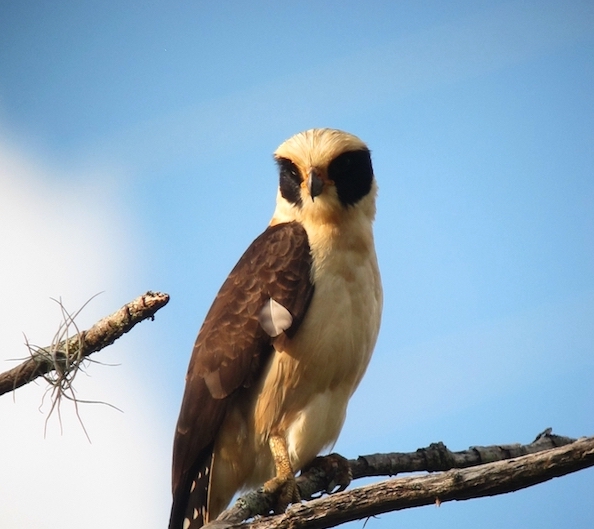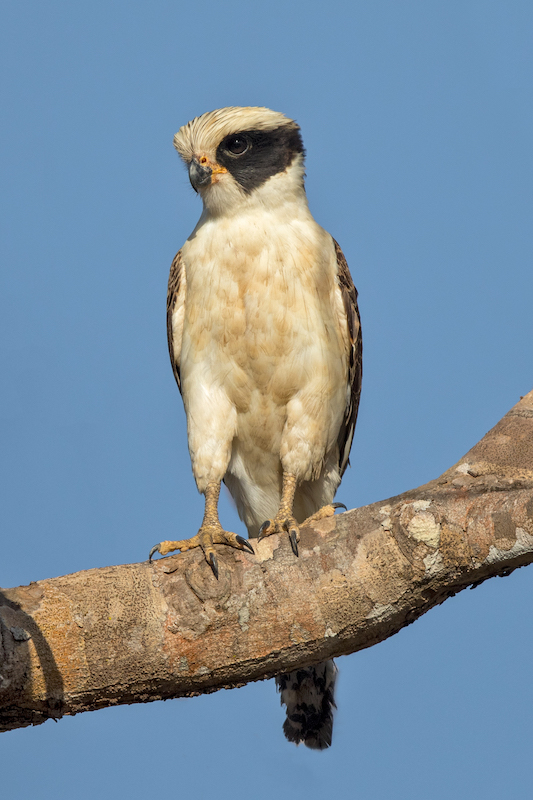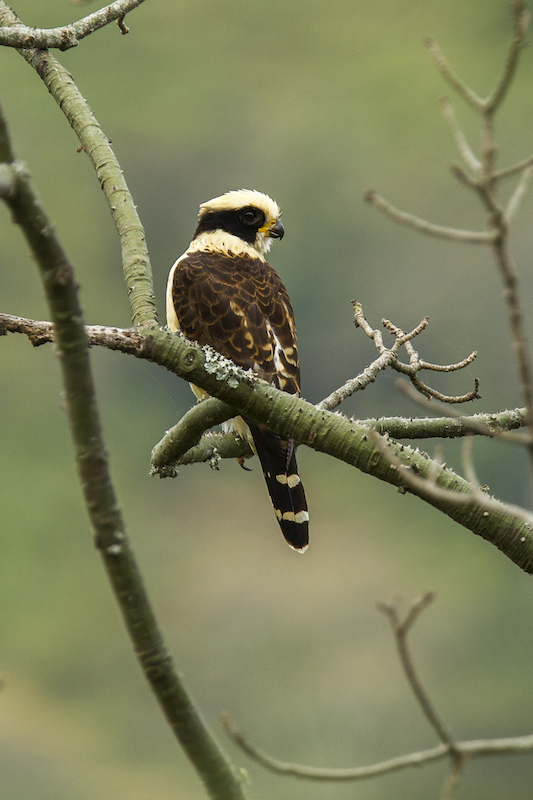The Laughing Falcon (Herpetotheres cachinnans)

BODY LENGTH: 45-56 cm (17.7-22 in)
WINGSPAN: Wing Length 247-294 mm (9.7-3.7 in)
WEIGHT: 544-800 g (19-28 oz)
Cool Facts
In some folklore, the Laughing Falcon is said to be able to predict the weather. If it is calling from a dead branch, there will be apparent blue skies; if it calls while perched on a limb with green leaves, it will rain!
This species doesn’t soar
The Laughing Falcon is considered to be one of the most conspicuous of all the raptors in the Neotropics.
Where They Live
The Laughing Falcon is a Neotropical raptor from northern Mexico, through much of Central America, and south into South America, to the north of Argentina. Unlike the Harpy Eagle, which is home in the dense lowland forests, the Laughing Falcon prefers more open areas with some tall trees to perch on.
It can be seen perched, soaring, hunting, and nesting in forest edges, gallery forests or along rivers, savannas, second-growth forests, and even near agricultural fields in the following countries: Argentina, Belize, Bolivia, Brazil, Colombia, Costa Rica, Ecuador, El Salvador, French Guiana, Guatemala, Guyana, Honduras, Mexico, Nicaragua, Panama, Paraguay, Peru, Suriname, and Venezuela.
In Costa Rica, They prefer the edges of deciduous and evergreen forests, fragmented forests, semi-open areas, secondary forests, and savannah trees. It is a relatively common resident species in the lowlands where it is not persecuted, both on the Pacific and Caribbean slopes. On rare occasions, they ascend to 1850 meters above sea level.
What They Do
Our imaginations might run wild – and it could be pretty fun – imagining why someone named a bird a «laughing» falcon. Does it laugh? Is it comical in some way? You would be right if you thought this bird was given this name because it sounds like it is laughing! If you are ever walking through Laughing Falcon habitat and hear something that sounds like a loud wah ha ha, it is probably a Laughing Falcon. These falcons tend to be most vocal right before and at dawn and dusk!
Once you hear it calling, if it is nearby, you may see it perched on a high, visible branch. And it is worth taking a long, close look at this raptor! This is one of the most distinctive, arguably the most beautiful, of the Neotropical raptors. This falcon perfectly blends blacks, browns, and off-white markings. The most distinguishing characteristic is the dark mask across its eyes and on the side of its face. This mask contrasts beautifully with its creamy white head and breast. It has a black and white banded tail, a yellow cere, dark legs, and eyes.
What They Eat
The most common prey taken by Laughing Falcons are snakes, both big and small, venomous and non-venomous, arboreal and terrestrial. However, its choice of food doesn’t stop there. It will prey on lizards, small mammals, birds, fish, and giant insects, such as grasshoppers. In Brazil, researchers also recorded these falcon-hunting bats.

When on the hunt, a Laughing Falcon will spend much time waiting and watching – sometimes hours. While it might not look exciting, don’t be fooled. This keen-eyed raptor is always on alert for prey slithering, walking, or hopping by. Once this falcon spots something that will make a good meal, it drops down to the ground or to lower levels in trees to snatch itself a feed. Researchers have reported that this falcon pounces on snakes with great force, «hitting the ground with an audible thud.» When it catches a snake, it holds it just behind the head with its beak. Then, it readily bites off the snake’s head.
Once its prey is «in hand,» it will fly to a perch where it will feed. If it has caught a small snake, it might carry it to its nest with its beak. If it has caught a larger snake, it will take the snake on its feet parallel to its body. When the falcon has finally settled in to eat, it will swallow small snakes, tail first. This falcon uses its sharp beak to rip more giant snakes into small pieces, which it then consumes.
Nests, Eggs, and Young
The Laughing Falcon, like many falcons, doesn’t build its own nest. It prefers to lay its eggs in natural tree cavities, clumps of epiphytes, at the base of palm fronds, or even in old nests built and abandoned by other birds, such as hawks or caracaras. On some rare occasions, it is known actually to nest on cliffs!
The female usually lays one egg, though sometimes she may lay two. The eggs are off-white, blended with reddish or dark brown markings. Once the eggs are laid, the female will spend the next 45 days sitting on and caring for her eggs. It rarely leaves the nest during this time and relies on the male to bring her food. After the nestling hatches, it must eat a lot to grow healthy and strong. When it is over two months old, it will be ready to fly from the nest for the first time. Even though it is flying, this young bird will still need to stay in its parents’ territory for two months while it learns to hunt and avoid dangers.
Researchers have noticed an exciting relationship between the trees the falcons nest in and ants! Sometimes, the falcons will nest in the same tree where aggressive ants have set up their homes. These ants don’t generally bother the falcons but attack other animals that come close. This close relationship helps protect falcon nestlings from mammalian predators and perhaps even botfly ectoparasites.

